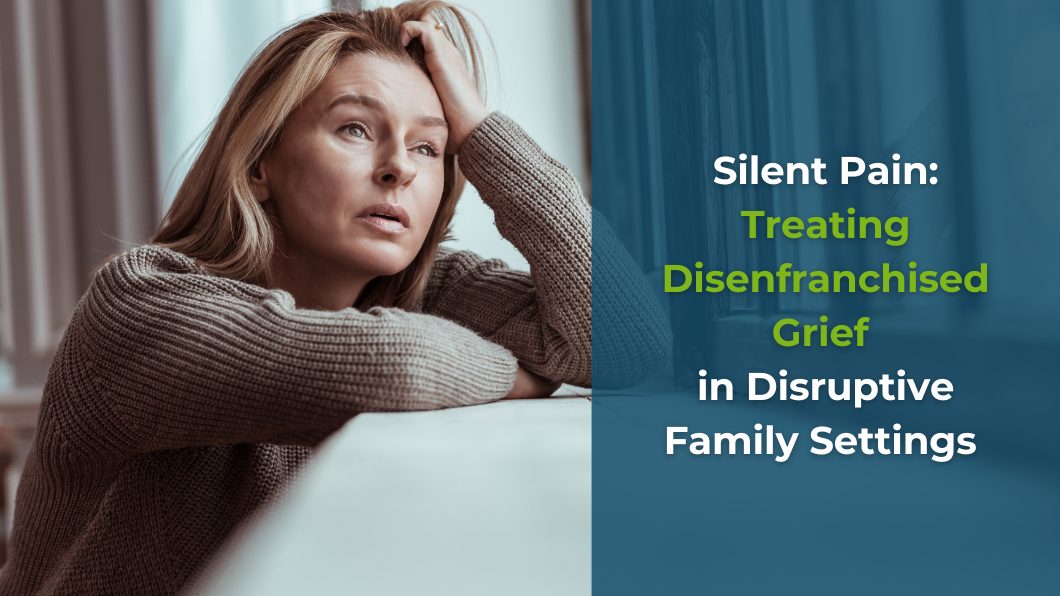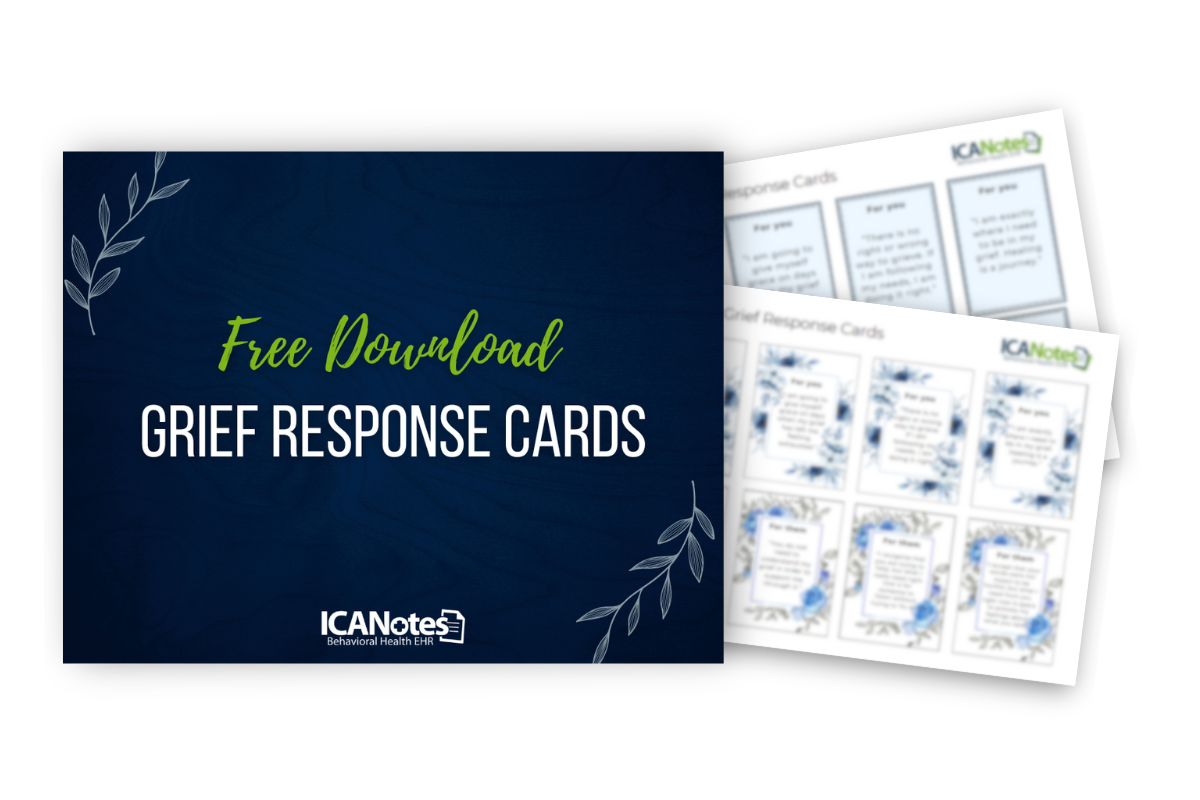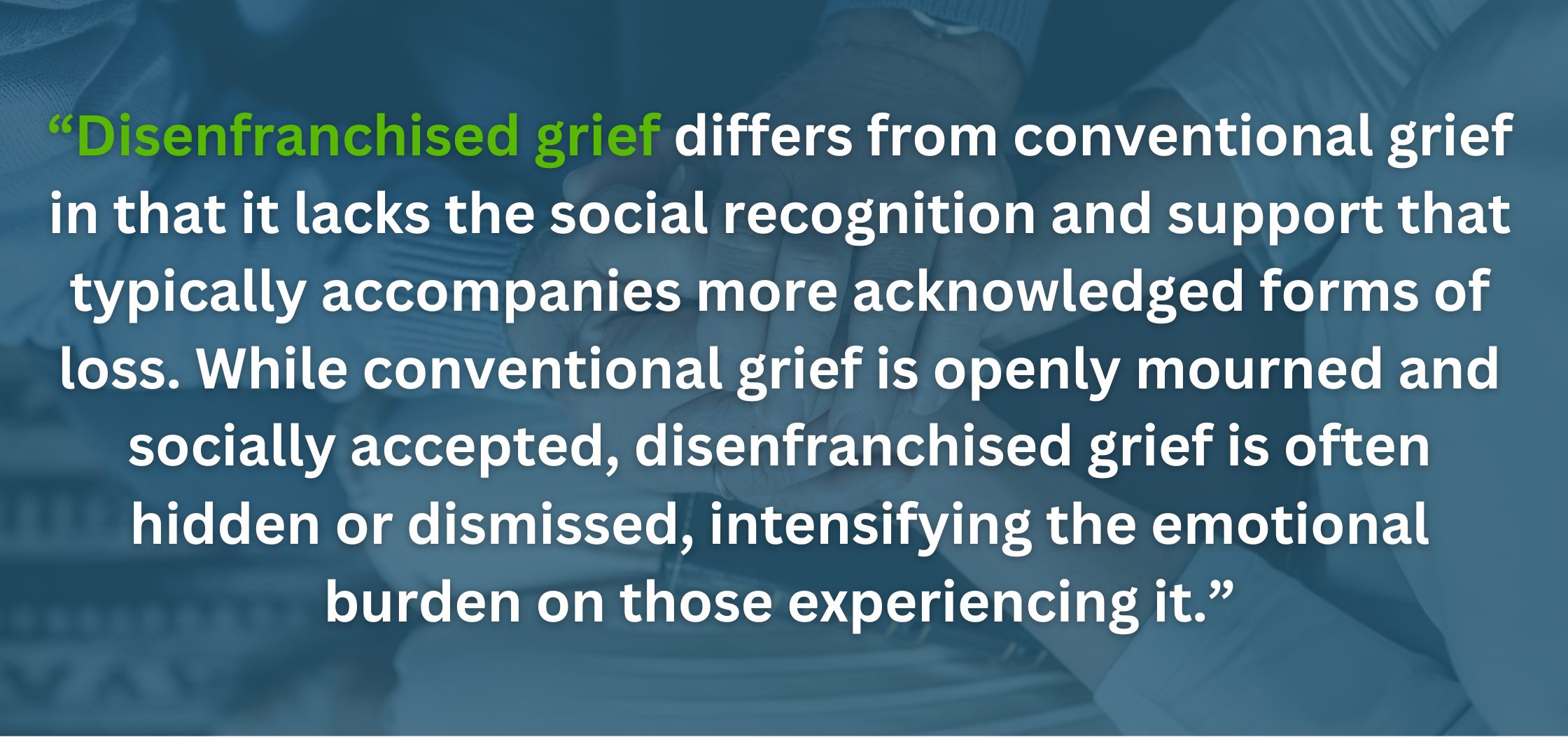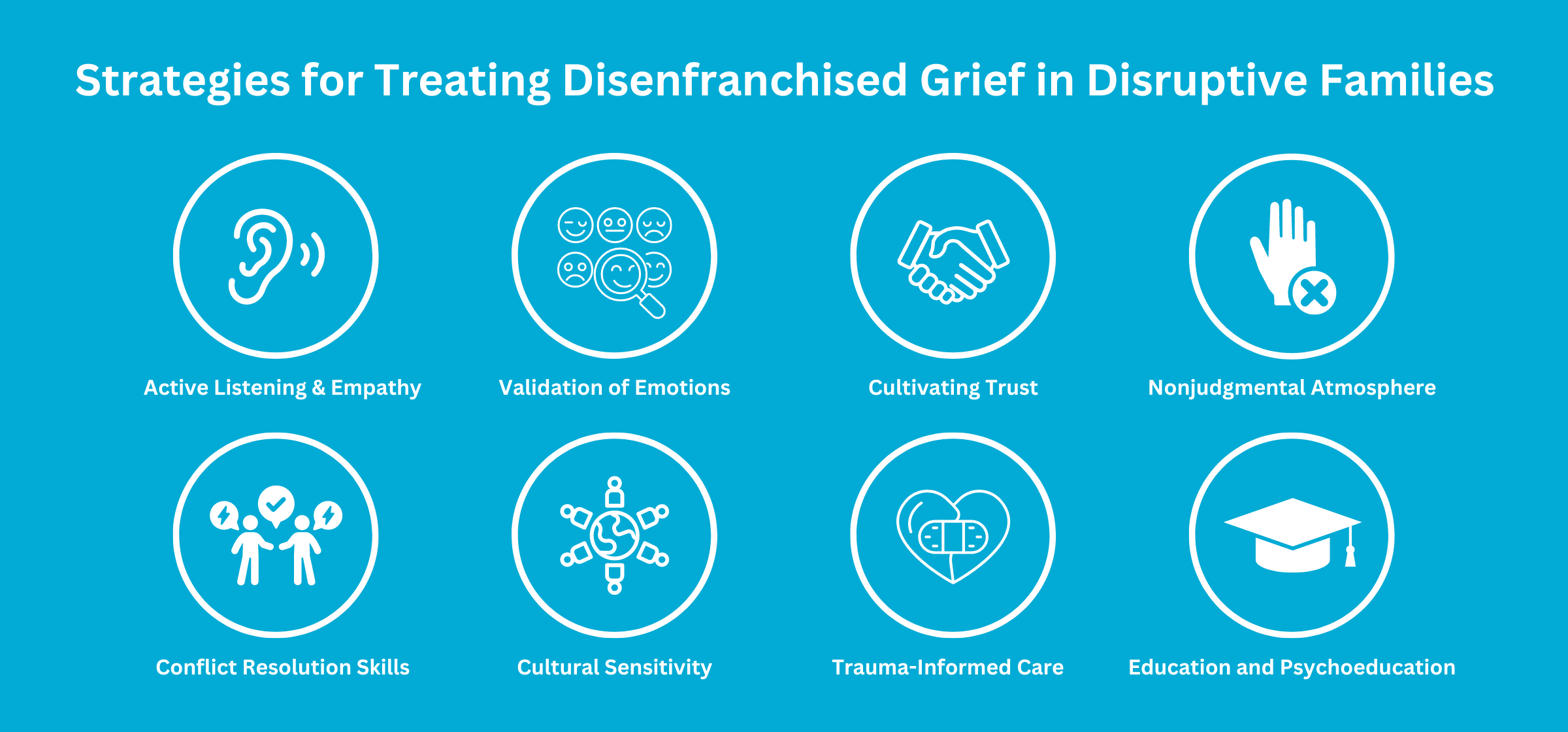
The Silent Pain Treating Disenfranchised Grief in Disruptive Family Settings
Introduction
Experiencing grief and loss is a challenging and often painful journey. It becomes more complex due to the interplay of personal history, life circumstances, the nature of the loss, and the relationship with the deceased or the lost entity. These factors vary from person to person and from one loss to another, profoundly influencing the grief process and resulting in a unique experience for each individual.
To understand the complexity and impact of disenfranchised grief, it is important to develop a working definition of grief. Grief is most often associated with loss through the death of an individual. Consequently, this belief can result in all non-death losses being experienced as disenfranchised grief. For the purposes of validating losses both inside and outside of death loss, we will define grief as something being taken from you without your permission. When expanding this definition, grief can be experienced through death, divorce or a significant relationship shift, job loss, food insecurity, physical and mental health issues, and so much more. This expanded definition seeks to validate common grief experiences that are often disenfranchised for so many.
With this in mind, it can be easy to see how disenfranchised grief can appear throughout a disruptive or conflictual family system simply through the relationships, or lack thereof, experienced by family members. The loss or complete lack of a healthy, supportive relationship as often modeled by society can create feelings of grief that are typically overlooked within a grief assessment.
Free Download: Printable Grief Response Cards
Download and share these cards with your clients to help them respond to hurtful comments related to their grief.

What is Disenfranchised Grief?
Disenfranchised grief refers to the grief that individuals experience when they incur a significant loss that is not openly acknowledged, socially supported, or publicly mourned. This type of grief often occurs when the loss is not recognized or validated by society, causing the grieving individual to feel marginalized or unsupported in their mourning process. Some common examples of grief that are seen as disenfranchised include suicide, drug overdose, miscarriage, pet loss, disability, or the unique grief faced by individuals in marginalized groups, whose losses may not receive widespread acknowledgment or understanding.
Outside of the circumstances surrounding death, grief can be disenfranchised as a result of the bereaved individual’s relationship to the person who has died. This can include relationships featuring a lot of conflict and estranged family members with whom contact has been cut off or strained. These conflicted relationships can result in friends and family assuming the bereaved feels relieved or lack emotion related to the death of the deceased, when oftentimes the opposite is true.
Lastly, much like life, relationships hold a high level of complexity which often creates scenarios wherein multiple factors are at play within one grief experience, compounding the disenfranchised grief even further. The concept of disenfranchised grief creates a uniquely complex process that can be difficult to navigate largely due to the lack of social support that often surrounds it.
Brief Explanation of Disruptive or Conflictual Families
Disruptive or conflictual families refer to family units characterized by ongoing disagreements, tension, or discord among their members. These conflicts can manifest in various forms, including verbal disputes, emotional turmoil, or even more severe issues such as abuse. These issues can surface throughout family systems, from parent to parent, parent to child, and sibling to sibling, creating home environments rife with conflict and misunderstanding.
Such family dynamics may impact the overall well-being of individuals within the family, influencing their emotional and social development. In these environments, relationships, not limited to parent-child bonds, can be strained, potentially leading to difficulties in navigating social contexts beyond the family unit. The disruptive nature of these families can affect the individual's social interactions, creating potential challenges in establishing and maintaining healthy relationships outside the family system.
The Importance of Addressing Disenfranchised Grief in Such Families
Grief, even when experienced by well-functioning family systems, disrupts a family system deeply, changes individual’s roles within families, and requires a high level of communication to truly ascertain what each person’s needs are. Simply put, it takes effort even under that best circumstance, to truly support a family member in grief.
One primary component of disenfranchised grief is feeling like your grief is not openly acknowledged or supported. Within disruptive families, feelings in general tend to be misunderstood, rejected, and ignored, leaving feelings of grief isolated and unacknowledged. Furthermore, while feelings like anger or sadness may pass with time, grief is an experience that needs witnessing – to be seen, heard, and understood by others in order to truly process the pain and rebuild.
Understanding and addressing disenfranchised grief in disruptive families is crucial for the well-being of individuals within these environments. Failure to recognize and validate grief can exacerbate emotional distress, leading to long-lasting consequences on mental health, relationships, and overall family dynamics. This blog delves into the complex nature of disenfranchised grief in such settings and explores strategies for effective treatment.

The Complex Nature of Disenfranchised Grief
Differentiating Disenfranchised Grief from Conventional Grief
While our culture struggles to support grief of any kind, there is a marked difference in how conventional grief and disenfranchised grief are addressed and supported. When considering conventional grief, we often associate these losses with the death of a parent, spouse, or child – better known as immediate family. These losses provide more allowance for social support, bereavement leave, and a generally longer period of outside recognition that you have experienced something devastating.
Disenfranchised grief differs from conventional grief in that it lacks the social recognition and support that typically accompanies more acknowledged forms of loss. While conventional grief is openly mourned and socially accepted, disenfranchised grief is often hidden or dismissed, intensifying the emotional burden on those experiencing it. When placing these two grief experiences side by side, the distress of disenfranchised grief will typically last longer due to the lack of support and recognition which inhibits the grieving individual from having their grief be witnessed by others.
How Disenfranchised Grief is Often Overlooked or Invalidated
A primary cause of grief being overlooked or invalidated is due to our collective cultural discomfort with death, dying, and bereavement. When someone in our orbit experiences a deep loss, we feel the compulsion to look away from it. This occurs for two reasons; the first is we are so rarely exposed to grief as children, we never learn how to truly process it for ourselves or support it for others. This creates adults that do not know how to support or process grief, thus raising children who cannot do so as well. This circular impact creates a society that fundamentally cannot recognize how to support individuals in grief.
The second cause is associated more with disenfranchised grief. This is associated with others' perception of your loss and the pain it causes them to think of such an event happening in their lives. Individuals who experience disenfranchised grief often have ‘the unthinkable’ happen to them, which creates incredibly high rates of discomfort in the people who should be there to support you.
Due to this genuine discomfort, social support will typically default to one, or several, of the following strategies. The first strategy is not showing up to be a support at all. The discomfort they feel over the cause of death, the nature of the relationship to the deceased, or the circumstances surrounding the loss, puts a true barrier between them and their willingness to show up. Another way disenfranchised grief can be invalidated is through the use of platitudes. Platitudes are common sayings or ideas that are intended to encourage people to feel better, but do much the opposite, leaving individuals feeling dismissed, isolated and misunderstood.
The Emotional Toll on Individuals in Conflictual Families
Disenfranchised grief, as mentioned earlier, is frequently overlooked or dismissed by society. Nevertheless, the essential component for healing in grief is the presence of at least one supportive figure who listens without judgment and is willing to witness the experienced grief without attempting to alter it. In well-functioning family systems, this crucial support is often found within the home environment.
However, the emotional impact of disenfranchised grief within conflictual families cannot be emphasized enough. Individuals in such circumstances may grapple with a spectrum of emotions, including sadness, guilt, anger, and profound loneliness. The absence of acknowledgment by individuals who should act as your primary support network further magnifies these emotions.
Identifying Disenfranchised Grief in Conflictual Families
Common Scenarios Where Disenfranchised Grief May Occur
Disenfranchised grief, concealed beneath the turbulent surface of conflictual families, manifests in various forms, each requiring a nuanced understanding for recognition and intervention. Three common scenarios highlight the complexities of this unique grief experience.
Within conflictual families, strained relationships often result in the loss of meaningful connections, giving rise to disenfranchised grief. Individuals grapple with the emotional aftermath of severed bonds, a significant loss that may go unnoticed amidst the continuous conflicts dominating the family dynamic.
Even in the face of a substantial loss, such as the death of a family member, the grieving process can be overshadowed by prevalent conflicts within the family. Grieving individuals may find their sorrow minimized or ignored, contributing to the experience of disenfranchised grief. The profound emotional impact of the loss may be eclipsed by the ongoing issues that preoccupy the family's attention.
The disruptive dynamics within families can also stifle individual aspirations, dreams, and personal growth. When these losses are not acknowledged or validated, individuals may undergo disenfranchised grief, mourning the unrealized potential within the stifling environment of their family. The unspoken pain of shattered dreams and aspirations may be hidden beneath the surface, requiring a careful examination of the family context to bring these emotions to light.
Understanding these common scenarios is essential for identifying and addressing disenfranchised grief within conflictual families, offering a path toward healing and acknowledging the multifaceted nature of sorrow concealed within the family unit.
Signs and Symptoms to Watch For
Identifying disenfranchised grief demands a discerning eye for subtle signs and symptoms that may be obscured by the ongoing turmoil within conflictual families. Some indicators to watch out for include withdrawal from family interactions, where individuals experiencing disenfranchised grief may seek solitude as a coping mechanism, creating a barrier that further isolates them from familial support. Additionally, sudden changes in behavior may manifest as unexpected shifts in mood, increased irritability, or a decline in overall well-being when grief remains unaddressed.
Conflictual families may overlook these signs, attributing them solely to ongoing issues within the family dynamic. Disenfranchised grief often leaves individuals with persistent feelings of sadness that endure over time, yet this enduring sorrow may not be readily apparent amidst continuous conflicts, as the family focuses on immediate issues rather than the underlying emotional struggles. Furthermore, the tumultuous nature of conflictual families can mask signs of disenfranchised grief, diverting attention from the emotional needs of grieving individuals and making it challenging to recognize and address their unspoken pain.
Identifying disenfranchised grief within conflictual families requires a nuanced understanding of the unique scenarios in which it may manifest and a keen awareness of subtle signs that may be obscured by ongoing turmoil. By shedding light on hidden sorrows, families can embark on a journey toward healing and understanding, fostering an environment where grief is acknowledged and embraced.
Challenges in Treating Disenfranchised Grief in Disruptive Families
To comprehend the challenges faced by disruptive family systems in dealing with grief as a unit, it is essential to adopt a family systems perspective on grief and loss. This approach allows us to examine each individual's experience of loss within the framework of intra and intergenerational relationship patterns. By doing so, we expand our viewpoint to encompass the diverse ways in which families collectively respond to such significant events. Within conflictual families, there tends to be an overall lack of understanding related to each individual family members unique process and needs in grief, creating a barrier between members and leading toward general misunderstandings

Strategies for Treating Disenfranchised Grief in Disruptive Families
Creating a safe and nonjudgmental therapeutic environment is a foundational strategy when addressing disenfranchised grief, particularly within disruptive families. This approach, supported by research conducted by Neimeyer et al. (2002), underscores the significance of the therapeutic setting in fostering healing and emotional expression. The following aspects further elaborate on the importance and implementation of this strategy:
- Active Listening and Empathy: Therapists should cultivate active listening skills to genuinely hear the concerns and emotions of individuals experiencing disenfranchised grief. Empathy plays a pivotal role, as it allows therapists to connect with the individual's unique experience and validate their feelings without judgment.
- Validation of Emotions: Acknowledging and validating the emotions associated with disenfranchised grief is crucial. Individuals in disruptive families may carry a burden of unacknowledged sorrow, and by validating their emotions, therapists help dismantle the sense of isolation and foster a supportive therapeutic atmosphere.
- Cultivating Trust: Establishing trust is fundamental for individuals to feel secure in expressing their grief. Disruptive family dynamics may contribute to a lack of trust, making it imperative that therapists build a strong therapeutic alliance. Trust encourages openness, honesty, and a willingness to engage in the therapeutic process.
- Nonjudgmental Atmosphere: Therapists should create an environment where individuals feel free from judgment or condemnation. Disenfranchised grief can already carry a sense of shame or societal disregard; therefore, the therapeutic space should be a refuge where individuals can share their experiences without fear of criticism or reproach.
- Conflict Resolution Skills: Disruptive families may be characterized by conflicts that exacerbate grief. Therapists need to possess effective conflict resolution skills to navigate and address family dynamics constructively. This involves mediating disputes, promoting understanding, and fostering healthier communication patterns.
- Cultural Sensitivity: Sensitivity to cultural differences is essential, as disenfranchised grief may be influenced by cultural norms and expectations. Therapists should be attuned to diverse cultural backgrounds, recognizing and respecting the impact of cultural factors on grief expression within the family context.
- Trauma-Informed Care: Disruptive families may have experienced various forms of trauma, contributing to the complexity of disenfranchised grief. Implementing trauma-informed care involves understanding the potential impact of those traumas on individuals and tailoring therapeutic approaches to promote safety and healing.
- Education and Psychoeducation: Providing information and psychoeducation about disenfranchised grief helps individuals and families comprehend the nature of their experiences. This knowledge empowers them to navigate the challenges more effectively and reduces stigma associated with unacknowledged grief.
The strategy of creating a safe and nonjudgmental therapeutic environment involves a multifaceted approach that encompasses active listening, empathy, validation, trust-building, conflict resolution, cultural sensitivity, trauma-informed care, and education. This comprehensive approach aims to address the unique needs of individuals experiencing disenfranchised grief within the context of disruptive family dynamics by tailoring interventions to suit the family’s unique dynamics.
Seeking Professional Help and Support for Disenfranchised Grief
Engaging support networks beyond the immediate family is crucial. According to William Worden, friends, extended family members, or community resources can play a pivotal role in providing additional layers of support. Building a comprehensive network helps individuals navigate the challenges of disenfranchised grief more effectively. Seeking support in grief is a crucial step toward healing. Finding the right fit for an individual’s particular needs in grief requires flexibility.
Here are several ways one may seek support in grief:
- Personal Support Systems:
- Family and Friends: Sharing feelings and experiences with close family members and friends provides emotional support.
- Social Networks: Engaging with broader social networks, both online and offline, can offer a sense of community and understanding.
- Grief Support Groups:
- Community-Based Groups: Local community organizations often host grief support groups where individuals can connect with others facing similar challenges. Consider looking into local hospice organizations and community centers.
- Online Forums: Virtual platforms and forums provide opportunities for people to share their experiences, seek advice, and find solidarity with a global community.
- Grief Counseling / Therapy:
- Individual Therapy: Seeking the guidance of a licensed therapist or counselor allows for personalized, one-on-one sessions to explore and navigate the complexities of grief.
- Group Therapy: Participating in structured group therapy sessions offers the benefits of shared experiences, mutual support, and the guidance of a trained therapist.
- Counseling Services: Many organizations and mental health professionals specialize in grief counseling, providing targeted support.
- Supportive Communities and Organizations:
- Religious or Spiritual Communities: For those with religious or spiritual beliefs, seeking support within a faith community can provide comfort and a sense of purpose.
- Nonprofit Organizations: Numerous nonprofit organizations focus on grief support, offering resources, helplines, and counseling services.
- Educational Resources:
- Books and Literature: Reading books on grief written by experts or individuals who have experienced similar losses can provide insights and coping strategies.
- Online Resources: Websites, blogs, and educational platforms often share information, tools, and resources for coping with grief.
- Workplace and Academic Support:
- Employee Assistance Programs (EAP): Many workplaces offer EAP services that include counseling and support for employees dealing with grief.
- School Counseling Services: Students can access counseling services provided by educational institutions to help cope with grief-related challenges.
Ultimately, the choice of seeking support depends on individual preferences and needs. Combining various forms of support often proves to be a comprehensive approach to navigating the complex journey of grief.
Conclusion
The journey of treating disenfranchised grief in disruptive families is fraught with challenges and complexities. From the subtle nuances of identifying unacknowledged grief to navigating the tumultuous waters of conflictual family dynamics, the path to healing requires dedication and understanding.
Additional Resources
By understanding the complexities, identifying the signs, and implementing targeted strategies, individuals and families can navigate the path to healing, transforming silent pain into a shared journey of resilience and recovery. For families in search of additional resources to support grief, visit the following resources:
In the face of adversity, acknowledging and addressing grief becomes a courageous act, especially for individuals coming from families that have historically invalidated or minimized thoughts, feelings, and emotions. According to Dr. Alan Wolfelt, the founder of The Center for Loss and Life Transition, and The Companioning Model of Grief, in order to heal grief, we must first feel it. Regardless of family structure or previous experiences, it is important for individuals and families to recognize the significance of their emotional experiences, fostering a culture of openness and healing within the often challenging context of disruptive family settings.
About the Author

Kaylee Kron, LMSW
Certified Grief Counselor through the American Institute of Healthcare Professionals
Kaylee earned her Master of Social Work degree through Boise State University as well as a Master of Strategic Marketing Degree through Bellevue University. Kaylee brings 10 years of social work experience supporting individuals, families and communities through her time as an adult behavioral health clinician, infant mental health clinician, and grief counselor. Kaylee found a passion for community building, event planning, and nonprofit partnerships while serving North Idaho through a nonprofit hospice as the Bereavement Coordinator and Community Support Services Manager.
Citations
Afolabi, Oladayo, Death, Grief and Family Dynamics: The Impact of Family Member's Death and Delayed Grief Resolution on the Family System. (May 2, 2014). Available at SSRN: https://ssrn.com/abstract=2826483 or http://dx.doi.org/10.2139/ssrn.2826483
NEIMEYER, R. A., PRIGERSON, H. G., & DAVIES, B. (2002). Mourning and Meaning. American Behavioral Scientist, 46(2), 235-251. https://doi.org/10.1177/000276402236676
Schulz, R. (1983). Review of Grief Counseling and Grief Therapy: A Handbook for the Mental Health Practitioner [Review of the book Grief counseling and grief therapy: A handbook for the mental health practitioner, by J. W. Worden]. Contemporary Psychology, 28(9), 727. https://doi.org/10.1037/022357
Turner, R. B., & Stauffer, S. (2024). Disenfranchised grief: Examining social, cultural, and relational impacts. Routledge, Taylor & Francis Group.
Weaver, C. M., Shaw, D. S., Crossan, J. L., Dishion, T. J., & Wilson, M. N. (2015, February). Parent-child conflict and early childhood adjustment in two-parent low-income families: Parallel Developmental Processes. Child psychiatry and human development. https://www.ncbi.nlm.nih.gov/pmc/articles/PMC4523123/
Why grieving parents detest platitudes, euphemisms, & jargon. (n.d.). https://www.psychologytoday.com/us/blog/laugh-cry-live/201909/why-grieving-parents-detest- platitudes-euphemisms-jargon
Wolfelt, A. (2006). Companioning the bereaved: A soulful guide for caregivers. Companion Press.










